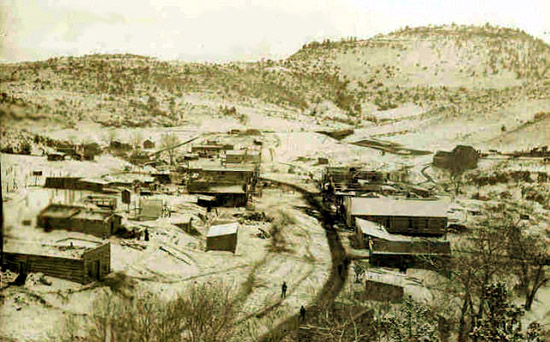
Hartville, 1898
Mining in the Hartville Range, however, preceded the coming of the Sunrise Mine discussed on the preceeding page. Nor was Sunrise the only iron mine
in the area. In the 1880's there was copper mining centered on Hartville. Nearby was Ironton, the mining camp for the Chicago Mine.
In 1878, John Fields, the manager of the stage station at Government Farm, 14 miles north of
Fort Laramie discovered an abandoned copper mine. Fields was later appointed by the government as the temporary custodian of
Fort Laramie upon its abandonment. It was speculated that the mine had been that of
earlier fur trappers or Indians. By 1881, there was a rush of miners into the area and by 1884 the town of
Hartville arose, named after Major (Brevet Lt. Col). Verling K. Hart who also located copper deposits in the area.
But by 1887, the copper rush had ended and the attention of miners turned to onyx and iron.
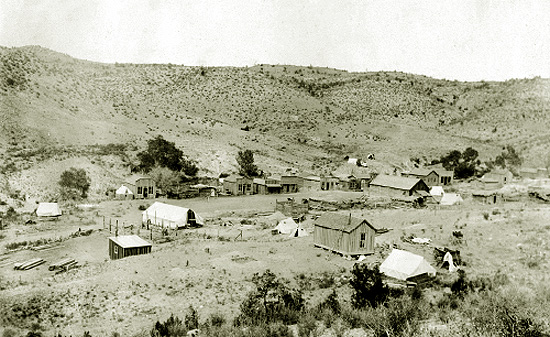
Hartville, 1899
IN 1897, the Blue Bird and Good Fortune iron mines opened. The Good Fortune was owned by Joseph J. Hauphoff and Ichabod S. Bartlett.
Bartlett later was the editor of the History of Wyoming, S. J. Clarke Publishing Company, Chicago, 1918.
Hauphoff, before coming to the Fort Laramie/Hartville Range area of Wyoming, was a saloonist and shoe store proprietor in Cheyenne. Later he operated
hotels at Fort Laramie and Badger. Badger, named for Assistant Postmaster General George Badger, was located where the Cheyenne and Northern crossed Cottonwood Creek.
The town basically consisted of a general store and Haughoff's hotel, the "Badger House," a one-story affair.
Before statehood, Hauphoff served as a United States Commissioner and later as a justice-of-the-peace. The later office
gave him the honorary title of "judge." A. W. Bowen in his 1901 Progressive Men of Wyoming described Hauphoff as being
"universal popular," perhaps a slight exaggeration. In August 1895, The Salt Lake Herald reported that "Judge" Hauphoff survived an
attempted assassination. After the establishment of the mines at Hartville, Hauphoff maintained ownership of the
scales, a source of unhappiness with the ore haulers who were paid by the ton. In Feburary 1998, Hauphoff was beseiged at his
scales by unhappy ore haulers who attempted to take over control of the scales. Hauphoff held the ore haulers
off with a winchester. Neverheless, it was necessary for the sheriff to travel from Cheyenne to calm the
situation.
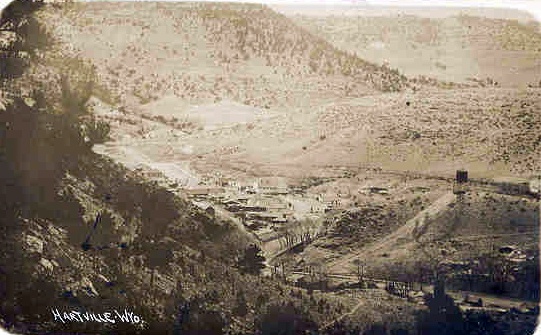
Hartville, 1912
One difficulty for mining in Hartville was the absence of a railroad. In 1896, Luke Voorhees (1835-1925), former manager of the Deadwood stage line, received the
contract to haul the ore from Hartville to Badger using 10 ore wagons and sixy horses. In the meantime, three different
companies began a race to provide rail service to Hartville. In 1897, there was discussion of the Union Pacific, Denver & Gulf constructing a spur. The only
difficulty was that the line was in receivership and it would require court approval.
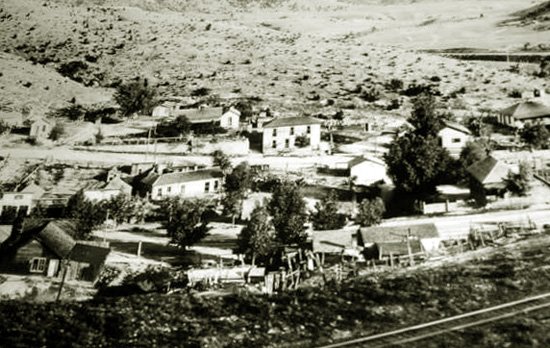
Hartville, 1926
In 1899, the Burlington begain construction of an extension from Alliance,
Nebraska to Hartville. Delays, however, were encountered. On May 13, 1899, officials of the Colorado Fuel and Iron Company, by then the operators of the
mines at Sunrise, incorporated the Colorado and Wyoming Railroad. The announced intention was to
construct a line from the Cheyenne and Northern to Hartville. In the meantime, the Denver and Gulf closed its mines in Hartville.
In 1900, the railroads arrived at Hartville. With the arrival of the railroads, Badger faded into non-existence, its site marked by reddish soil from the
spillage from the ore wagons and rememered only in the name of a road and
a voting precinct.
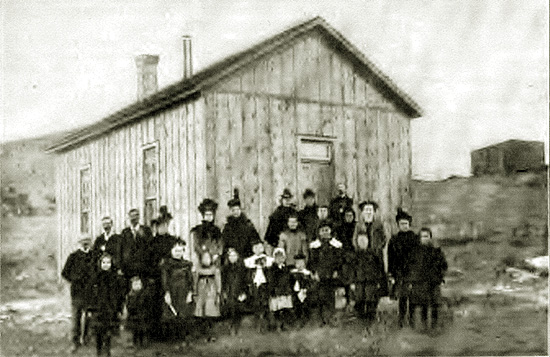
Sunday School class in front of Hartville School, 1900
With the arrival of the railroads, Hartville was incorporated as a municipality. A public subscription was taken up for the construction
of a school which would double as a Sunday school on the Sabbath. Nothwithstanding his previous difficulties at the
scales, Hauphoff was elected as mayor. Hartville, in contrast to Sunrise, was an "independent town," meaning that it was open to saloons and other establishments appealling to
bachelor miners. At the time, Hauphoff was described as the proprietor of a "house for the accomodation of the trading public." With the saloons
and other establishments, there was a certain amount of roughness. In 1899, Hartville was frequented by Charles Saunders, a professional gambler who was, in the words of
the Omaha Daily Bee, January 5, 1900, "the terror of the new town" According to the Bee, Saundrs carried both a six-shooter and a bowie knife on his person at all times.
In December, 1899, a person unknown managed to do in Saunders without having to face a shootout. Saunders was poisoned. In 1907, Hartville made the national
news when miner Ernesto Jacobetti was shot, according to the New York Tribune, December 27, 1907, "squarely between the eyes." The bullet went straight through
his head. The amazing thing, however, according to the Tribune was that not withstanding "after having lost about one-half of his brains" which "oozed" through the hole in his head made by the
bullet, he recovered with no perceptible loss of mind or memory and within three weeks was back at work in the
mines. The last shootout on Main Street was in 1912.
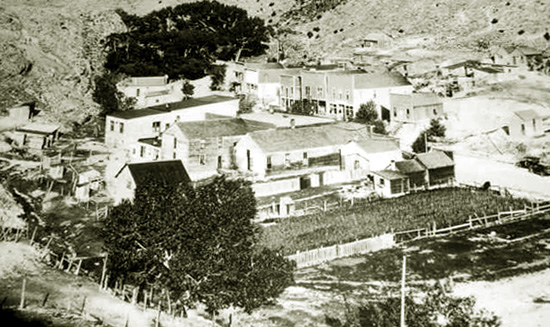
Business Section, Hartville, 1926
In 1903 Hauphoff faced opposition in the campaign for
reelection from Nettie (Mrs. George) Catlin. Mrs. Catlin was the first woman to run for the position of mayor in a Wyoming town.
She was the wife of physician Dr. George S. Catlin (1848-1923). Mrs. Catlin between 1908 and 1922 accumulated 555 acres of mining patents in
the Hartville area. In 1906, the election received national attention. As reported by the
San Francisco CallJanuary 1, 1906:
CHEYENNE, Wyo. May 31 -- A bold attempt was made today to seize the city government of Hartville, a
mining town in the northern part of this county, but mayor J. J. Hauphoff, who is in Cheyenne, defeated the movement with armed
deputies.
Early this morning J. H. Wilde, who was recently elected Mayor of Hartville, and who had been prevented from
taking his seat by J. J. Hauphoff, who refuses to canvass the vote, assisted by ex-marshall George Fenton. kidnapped Acting Police Judge J. M. Adams and
locked him in the city jail. The conspirators were about to seize the hall when Mayor Hauphoff, who had been notified
by telephone, directed Wilhelm Somers to appoint all deputies necessary, arm them and demand the release of Adams. The deputies marched upon the jail and Wilde
communicated with his attorneys here, who advised him to release Judge Adams.
Adams' first act on gaining his freedom was to issue bench warrants for Wilde and Fenton, charging them with conspiracy,
kidnapping, highway robbery, etc. The warrants have not been served and the town is in a fever of
excitement. Mayor Hauphoff was beaten at the recent election, but refused to abdicate. There is danger of bloodshed, for all the
parties are fighters.
With the closure of the mines in Sunrise, Hartville has lost population. In 1980, at the time of the mine closing in
Sunrise, Hartville had a population of 246. As of the 2000 Census, it had a population of 76.
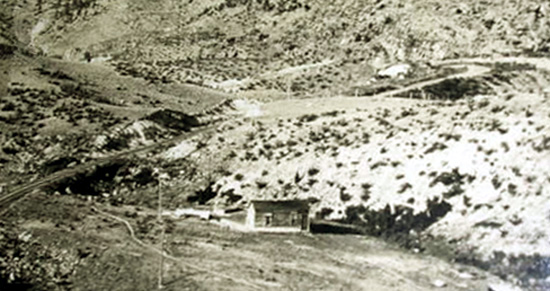
Road into Hartville, 1926
Next Page: Torrington.
|